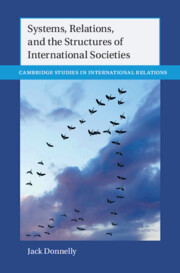Book contents
- Systems, Relations, and the Structures of International Societies
- Cambridge Studies in International Relations
- Systems, Relations, and the Structures of International Societies
- Copyright page
- Contents
- Figures
- Tables
- Acknowledgments
- Part I Systems, Relations, Levels, and Explanations
- Part II Waltzian Structural Theory
- 5 Structural Theory
- 6 Anarchy
- 7 The Tripartite Conception of Structure
- 8 Functional Differentiation and Distribution of Capabilities
- 9 Ordering Principles
- Part III Systems, Relations, and Processes
- References
- Index
- Cambridge Studies in International Relations
5 - Structural Theory
from Part II - Waltzian Structural Theory
Published online by Cambridge University Press: 19 October 2023
- Systems, Relations, and the Structures of International Societies
- Cambridge Studies in International Relations
- Systems, Relations, and the Structures of International Societies
- Copyright page
- Contents
- Figures
- Tables
- Acknowledgments
- Part I Systems, Relations, Levels, and Explanations
- Part II Waltzian Structural Theory
- 5 Structural Theory
- 6 Anarchy
- 7 The Tripartite Conception of Structure
- 8 Functional Differentiation and Distribution of Capabilities
- 9 Ordering Principles
- Part III Systems, Relations, and Processes
- References
- Index
- Cambridge Studies in International Relations
Summary
This and the following four chapters address the systemic/structural theory of Kenneth N. Waltz. Despite extensive criticisms of its details, Waltz’s account of the nature of system, structures, and systemic/structural theory continues to predominate in contemporary IR. This chapter shows that, despite its systemic starting point, Waltzian structural theory is thoroughly analytic. Waltz replaced components arranged and operating as parts of a structured whole with a reified structure that exerts causal effects on units that interact with one another and with the structure. The resulting one-sided explanation of the actions of “units” by “the system” reduces systems to mere environments of autonomous actors (whose activities are not constituted, generated, or structured by being parts of a system but are simply constrained by external “system-level” forces).
Keywords
- Type
- Chapter
- Information
- Publisher: Cambridge University PressPrint publication year: 2023

